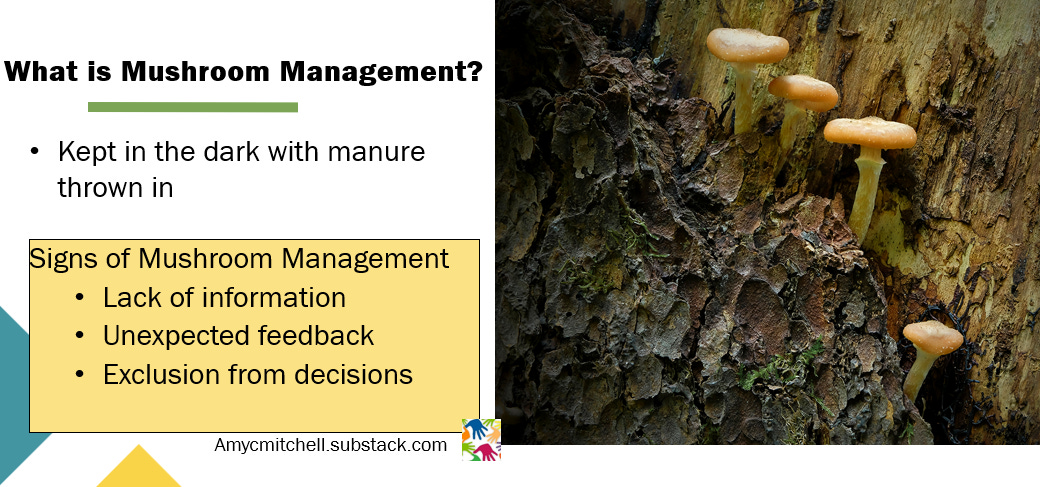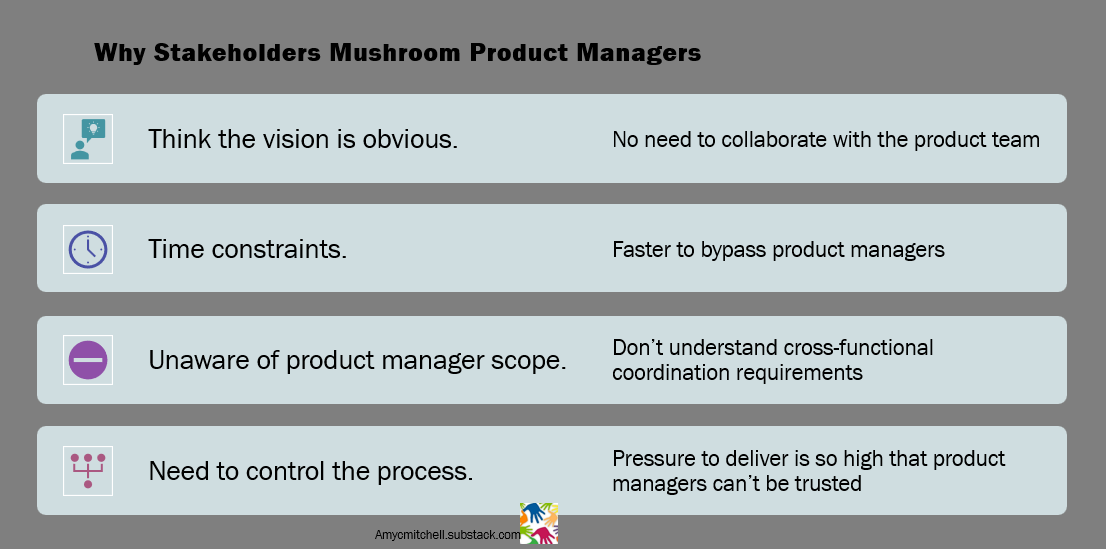The email arrived after dinner. It was from a stakeholder to your engineering lead. The stakeholder says disaster recovery is not a high priority.
How does this make you feel? Don't customers expect disaster recovery to work?
You are looking for a new UX requirements plan. The same stakeholder reports the UX team will be done soon. He doesn't know if your requirements are included.
How do you feel now? Is this why the UX team isn't responding to you?
You request legal help with a contract. The same stakeholder responds that he hasn't read the contract, but it is done.
Are you feeling frustrated now? Who gives guidance to legal?
This treatment is often called "mushrooming" or "mushroom management".
What is Mushroom Management?
Some of the best mushrooms grow in the dark with manure sprinkled on top.
Mushroom treatment is when people are kept in the dark with manure thrown at them.
For product managers, mushrooming looks like:
Lack of information: holding back on key details from product managers
Unexpected feedback: unhelpful comments with no context
Isolation: excluding product managers from important decisions
These practices are frustrating to product managers trying to do their best work.
Often stakeholders don't realize how their mushroom treatment impacts product managers.
Why Are Stakeholders Doing Mushroom Management to Product Managers?
Mushroom management goes back to the 80s as a way to reduce workplace stress and keep workers focused on output.
This approach fell out of style as new leadership approaches became successful.
In the past year, there has been a resurgence of mushroom management especially around product management. Some of the reasons for more mushrooming are:
Stakeholders believe the vision is obvious: the direction is so clear that no collaboration is needed
Time constraints: thinking it is faster to bypass product management
Unaware of the scope of product management: don't understand the cross-functional demands on product managers
Need to control the process: pressure to deliver is so high that they can't trust product managers
This means product managers are experiencing mushroom management more often.
How to Respond to Mushroom Management
Just because this is happening more and stakeholders are under immense pressure, don't try to fight this treatment. Showing your frustration at the lack of collaboration will cause more trouble for your product.
Product managers can turn around mushrooming into better product results. Mushroom management has benefits that you don't want to lose in moving to a collaborative approach. Some of the benefits to preserve in the turnaround are:
Strong cross-functional communications: mushroom managers are already heavily involved with the functional teams
Aligned strategy and execution: mushroom management demands a detailed understanding of each function delivering the outcome
Rapid decision-making: centralized mushroom managers set the direction without hesitation
This means product managers who reclaim their role need to finesse the changes and demonstrate the benefits of collaboration.
Finesse in Reclaiming the Role of Product Management
Mushroom managers are attuned to delivering value to customers. Product managers can build this into a shared goal. A shared goal leads to understanding product expectations. Collaborating on expectations gets to the heart of a complete product that meets business goals and delights customers.
How can product managers affect this change?
Reclaiming the product management solution takes effort on multiple fronts:
Provide data and clear communication: give the customer's perspective on the solution
Regular updates to keep stakeholders informed on progress: prove that you can deliver on your own
Frame up decision-making: show the efficiency of structured decision-making with the product team
Feedback in the open: the product team determines product success transparently
Each item brings product decisions out of the dark and into a complete solution.
Real-World Examples of Turn-Around
Standing your ground to powerful stakeholders takes grit and presence. Each mushroom management event needs multiple counters to prove that product management is a better solution.
Example 1: stakeholder goes to engineering with bad priorities
Issues:
Priorities not in the context of the customer's use case
Priorities in conflict with the roadmap
In progress development could be halted
To prepare for a different approach:
Regular updates with engineering on the roadmap and customer use cases
Agree with engineering on the change process
Product team and stakeholder alignment on near-term product deliveries
Result: priorities are openly handled by the product team
Example 2: Stakeholder claims dependent team has delivered
Issues:
Dependent team requirements are unvalidated
The customer's solution is unclear
Collaboration is missed
To prepare for a different approach:
Regular updates to stakeholders on product team plans
Lots of opportunities for stakeholder contribution - feedback, resources, direction
Product change process to manage impacts of new items
Result: Clear understanding of the solution delivered to customers
Example 3: Stakeholder wants to focus on a new customer opportunity
Issues:
Existing customer requirements are delayed
The financial forecast is out of date
Marketing messaging is not aligned
To prepare for a different approach:
Regular review of roadmap and change requests with the product team
Product change request process
Regular product updates to stakeholders showing delivery track record
Result: Structured decision about pursuing the new opportunity
Build stakeholder trust in the product team to deliver.
Conclusion - Combat the Rise of Mushroom Management
As a product manager, breaking free from the frustrations of mushroom management isn’t about pushing back—it's about pulling stakeholders into the light. By promoting structured decision-making, fostering open collaboration, and providing continuous feedback, you can turn bottlenecks into opportunities for alignment and clarity.
Rebuilding trust and influence takes patience and persistence, but the payoff is immense: a product team empowered to make decisions, deliver customer value, and drive business success.
Remember, the best antidote to mushroom management is shining a light on the process—because when everyone can see the path, great products grow.
TLDR Product listed Product Management IRL articles recently! This biweekly email provides a consolidated email of recent product management articles.
Last week’s backstory for paid subscribers was about removing product strategy obstacles. Was the Product Strategy Used?







I enjoyed reading your article, Amy! I hadn't heard of the phrase mushroom management before, but it's a great analogy. Open, transparent communication and great collaboration between all parties is key.
On the flip-side though (and as a novice mushroom picker back in the day), mushrooms tend to multiply and spread if they are left alone to grow in the wild! In a business sense, far too little stakeholder involvement and check-ins could have similarly negative business outcomes.
This article hit me hard—it’s such a perfect breakdown of "mushroom management," and @Amy Mitchell's practical strategies for product managers are a breath of fresh air. I especially loved the reminder that frustration won’t fix the problem but bringing stakeholders into the light will.
One question that came to mind: How would you suggest product managers build trust in particularly high-pressure environments, where stakeholders feel compelled to "bypass" for speed?